
A Complete Guide to Workplace Safety Signs
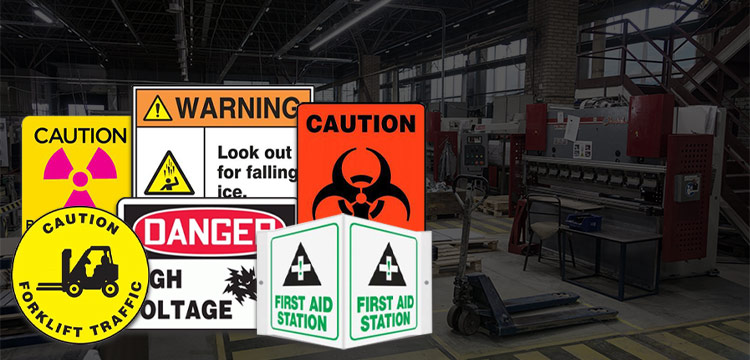
Safety signs are used across industries to promote workplace safety. They reduce accidents and injuries by serving as easily recognizable indicators of potential hazards. As such, industry partners must ensure that proper and compliant signage is displayed according to the appropriate standards.
This extensive guide to workplace safety signs, their meanings, and best practices for use is designed to help you navigate the complex web of rules and regulations that govern their display. Use it as a resource to help guide your workplace safety policies and safety sign buying decisions.
Table of Contents
- Safety Signs in the Workplace
- Safety Signs: Color Coding and Meaning
- Types of Safety Signs
- OSHA Regulations
- Military & ANSI Standards
- Where to Place Safety Signs
- FAQ
Safety Signs in the Workplace
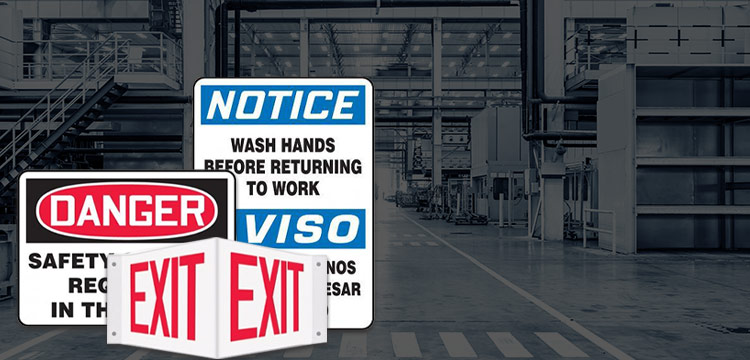
There are many different applications for safety signs in the workplace. In general, they serve one of the following three main purposes.
To Provide Direction: Some workplace signage is used to designate specific locations or traffic patterns. This includes smoking area signs, hand washing signs and room name signs. Exit signs and barricade signs ensure you know where you can and can’t go. This ensures work zone safety by directing people and items to appropriate areas.
To Provide General Information: When you need to convey information or instructions, or you want to share safety quotes for work, general information signs are a useful tool. Instructional signs detail safety topics for work on a specific machine or operating line, and housekeeping signs direct workers to follow proper sanitation and hygiene practices.
To Warn of Potential Dangers: Some signs are displayed to warn of increased risk of danger. These should always be color-coded according to the level of risk and worded to clearly indicate a potential hazard. Funny safety signs have no place here. Be direct and use positive, action-oriented wording to get your message across quickly and clearly.
Safety Signs: Color Coding and Meaning

Colors play an important role in conveying safety and road work sign information quickly and effectively. The American National Standards Institute and Occupational Safety and Health Administration developed standards to assign meaning to specific colors. This helps ensure that signage is consistent across industries, and that company messaging is delivered in a concise manner.
- Red: The color red is used on DANGER signs and STOP signs. It conveys a high risk of danger that could result in injury or death. Fire suppression equipment and emergency stops or alarms are red to increase their visibility.
- Orange: Moderate risks of danger, like those posed by equipment or sharp edges, should be designated by orange WARNING signs. Road construction signs, under construction signs and other traffic safety signs are printed on an orange background.
- Yellow: According to OSHA standard 1910.145(d)(4), situations that require caution are denoted with yellow-and-black CAUTION signs. No trespassing signs designed to keep people from potential harm may use this color combination. In addition to trespassing signs, hazard and flammable material storage containers and doorway obstructions will be marked with yellow CAUTION signs.
- Fluorescent Orange or orange-red with contrasting lettering is used to denote a biological hazard.
- Green: Green safety signs mark first aid and safety equipment.
- Blue: A blue background on safety signs indicates that a piece of equipment is under repair and should not be started or moved.
- Purple: Purple is reserved for safety signs marking radioactive material and hazards. These are generally on a yellow background with a graphic clearly designating the hazard.
Types of Safety Signs
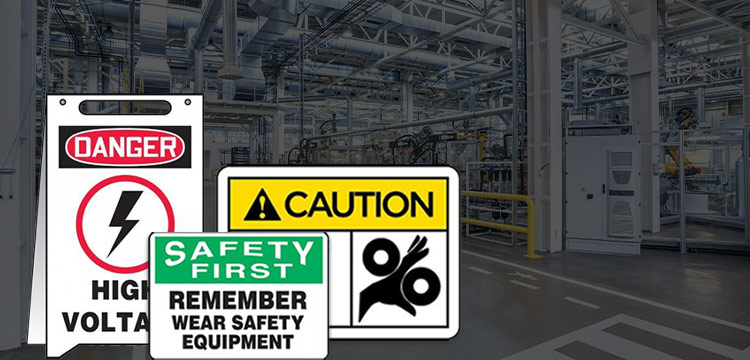
There are three main classifications of safety signs according to OSHA. These are:
- Danger signs indicate a serious immediate threat that will cause grave injury or death if it is not avoided. They will be a combination of red, black and white with the word DANGER across the top. Orange warning signs may be used to draw attention to a less serious or less immediate threat.
- Caution signs denote the risk of a minor or moderate injury. They have a yellow background with black upper panel, borders and lettering. The upper panel displays the word CAUTION, sometimes accompanied by a graphic.
- Safety instruction signs are informational signs that tell workers about policies and procedures. They may have instructions for hygiene practices or equipment operation and shutdown steps. Instructional signs must be white with a green upper panel with white letters. Additional lettering and graphics are black on the white background.
There are several other, smaller categories of safety signs including:
- General safety signs may be road safety signs, construction safety signs, no smoking signs or electrical signs to warn of danger or shutoff locations.
- Admittance signs and no trespassing signs detail who can and cannot enter a designated area.
- Fire safety signs will have white lettering and graphics on a bright red background. They are easy to spot and mark fire extinguishers, hoses and other fire suppression systems.
- Non-hazard signs include traffic signs and safety area directional signs.
For temporary applications, lightweight safety tags may be used in place of signs. They must comply with all color and design requirements as laid out under OSHA and ANSI standards.
OSHA Regulations
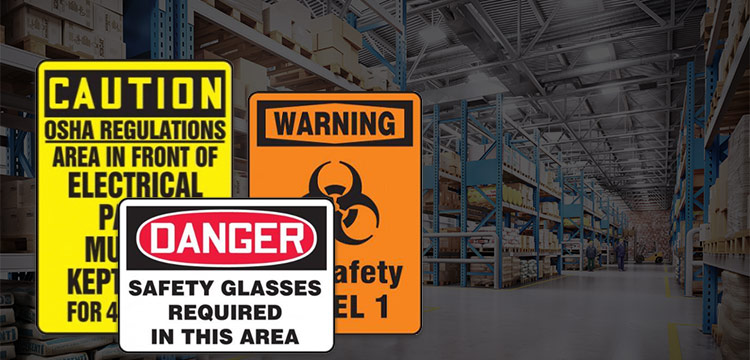
The Occupational Safety and Health Administration is the main governing body for developing U.S. regulations and standards for workplace safety. OSHA standards and regulations lay out the specific requirements for signage. Failure to comply with those requirements puts you in violation of federal workplace safety laws.
OSHA describes a standard or regulation as “… a regulatory requirement established and published by the agency to serve as criteria for measuring whether employers are in compliance with the OSH Act laws. OSHA standards are published in Title 29 of the Code of Federal Regulations (CFR) and are divided into separate standards for General Industry, Construction, and Maritime.”
Safety warning signs play a large role in maintaining workplace safety. They must be posted in accordance with all requirements of your specific industry. OSHA 1926.200(a) states that OSHA signs must be “visible at all times when work is being performed, and shall be removed or covered promptly when the hazards no longer exist.” They must be posted where they are visible from a set distance, in most cases five feet.
OSHA-compliant safety signs will be made of a material that is appropriate for the location where they are posted. In most cases, that will be a sturdy material designed to withstand conditions in your facility such as aluminum or heavy plastic. Some safety signs are also available in adhesive vinyl for direct application onto a wall, piece of equipment or another smooth background. They must have “rounded or blunt corners and shall be free from sharp edges, burrs, splinters, or other sharp projections. The ends or heads of bolts or other fastening devices shall be located in such a way that they do not constitute a hazard” as listed under OSHA 1910.145(d)(1)
PPE signs serve as a reminder for workers to wear appropriate gear such as glasses, helmets, gloves or masks. Biohazard signs serve as a further warning to take proper precautions.
In some cases, signage may be required to inform the public about potentially hazardous situations. Community safety signs indicate access requirements, entrances and exits and help with wayfinding. They are often brown, blue or green depending on their function. Fluorescent yellow-green is approved for pedestrian, bicycle, and school crossing warning signs.
Military & ANSI Standards
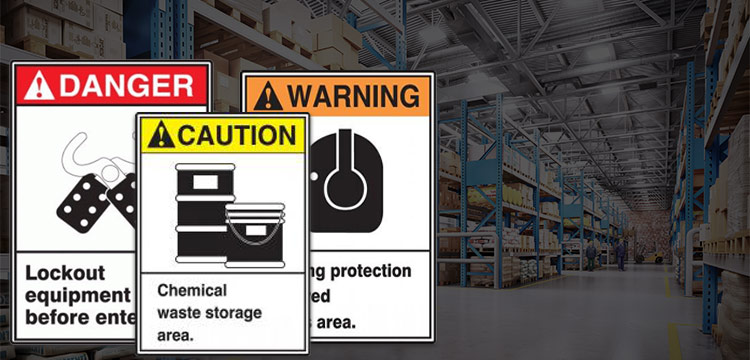
In addition to OSHA and ANSI standards, all safety and security signs used in military applications must meet standards set forth in MIL-DTL-15024F. Its specification sheets outline extensive physical requirements for materials, design and packaging of all military signs, plates and equipment tags.
All materials for Military and federal government applications must also adhere to federal procurement guidelines. The Department of Defense Index of Specifications and Standards and the Office of Federal Supply and Services Index of Federal Specifications, Standards and Commercial Item Descriptions are useful resources for navigating the purchasing process of appropriate OSHA and ANSI safety signs.
U.S. General Services Administration Global Supply regulations state that any material that can be classified as a physical or health hazard should be marked with special chemical safety signs. Hazardous materials are commonly referred to as HAZMAT and labeled with safety hazard signs bearing that description. Materials that generally fall under HAZMAT guidelines in military and civilian applications include chemicals that are known to be:
- Toxic or highly toxic agents
- Carcinogens
- Harmful to reproductive processes
- Irritants
- Corrosives
- Damaging to the lungs, skin, eyes, or mucous membranes
- Combustible liquids
- Explosives
- Compressed gases
- Flammable liquids or solids
- Unstable at rest or when exposed to water
ANSI signs should always be used to denote these items and proper storage locations. Emergency supplies should be marked with first aid signs that are highly visible in case of accidental exposure.
Confined spaces, defined as a space that is big enough to fully enter and perform work in, but has restricted access and is not designed for continuous use, must be marked with appropriate confined space signs. OSHA standard 1910.146 addresses permit-required confined spaces that may contain hazardous material.
Where to Place Safety Signs
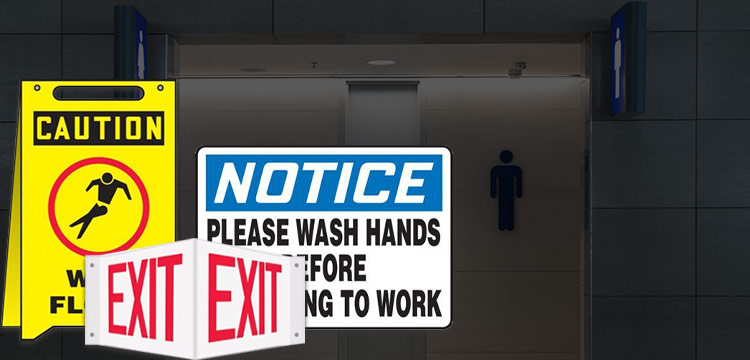
Proper sign placement increases its effectiveness. In general, no sign should interfere with the placement or message of another sign. It should also be visible from a set required minimum distance.
The best way to determine whether you are meeting requirements for sign placement is to check the appropriate local and OSHA standards. While you may need additional signs depending on your specific situation, you can get started by checking your signage to see if it meets this basic guide to workplace safety signs:
- All evacuation routes are marked with appropriate evacuation signs. (Add periods to all bullets)
- Exits from individual rooms and buildings are clearly marked with red and white exit signs.
- Areas where food is prepared display hygiene and food safety signs.
- Hazardous materials are clearly labeled with appropriate HAZMAT designations.
- Equipment and general hazards are all marked with proper warehouse safety signs.
- All restrooms are marked with restroom signs.
Having the proper signs posted in the correct locations helps keep workers, customers and visitors safe. This guide to workplace safety signs helps you know which signs you need so you can post them where people will easily see and recognize them.
Guide to Workplace Safety Signs FAQ
What are safety signs?
Safety signs are placards that can be placed throughout workplaces to help ensure safety. They are used in manufacturing, agricultural and traffic situations to remind workers of requirements, help them locate items and specific areas, and raise awareness of potential hazards.
What do safety signs mean?
The meaning of a safety sign is determined by the color, shape and graphics used on it. Red generally means danger, yellow indicates a need for caution and blue is used for information signs.
What is the purpose of safety signs?
According to OSHA 1910.145(a)(1), safety signs are used to “define specific hazards that could harm workers or the public, or both, or to property damage.”
Why do we need safety signs?
Safety signs are a crucial component of workplace safety measures. They alert workers to potential hazards, direct traffic and help in identifying emergency equipment. This reduces accidents and injuries in the workplace.
What color is a warning safety sign?
Per OSHA and ANSI standards, warning signs should have an orange background.
What health and safety signs do I need to post?
The specific signs you need to post will depend on the type of business you operate. According to OSHA’s Hazard Communication Standard, you can use signs that comply with ANSI Z35.1-1968 or ANSI Z535.2-2011, and ANSI Z35.2-1968 or Z535.5-2011 in addition to OSHA signs.
Where can you find the rules for safety sign usage?
Safety standards, laws and regulations are listed on the OSHA website under standard 191.145(a)(1).
What do blue health and safety signs mean?
Blue signs are used to warn workers against moving or starting equipment that is undergoing repair. You may see it near ladders, scaffolding or electrical controls.

